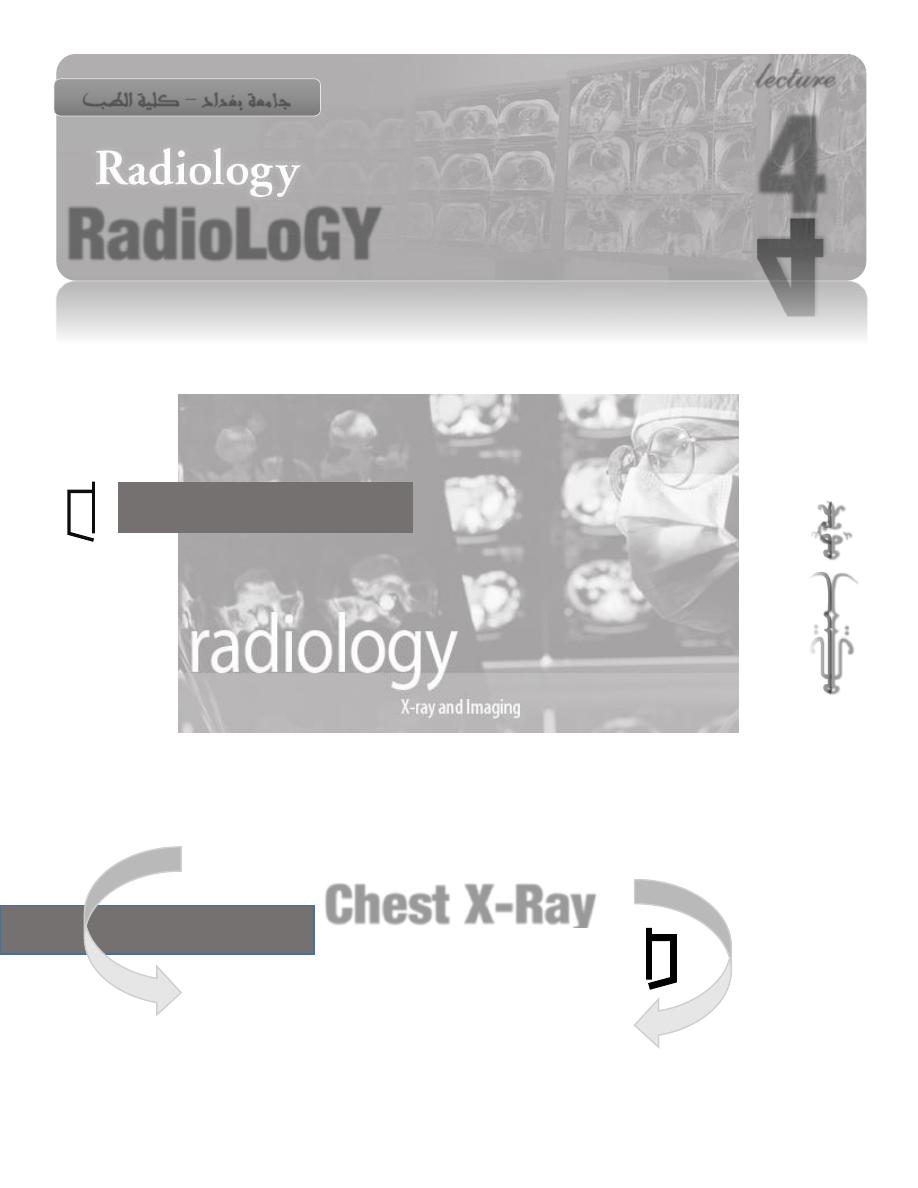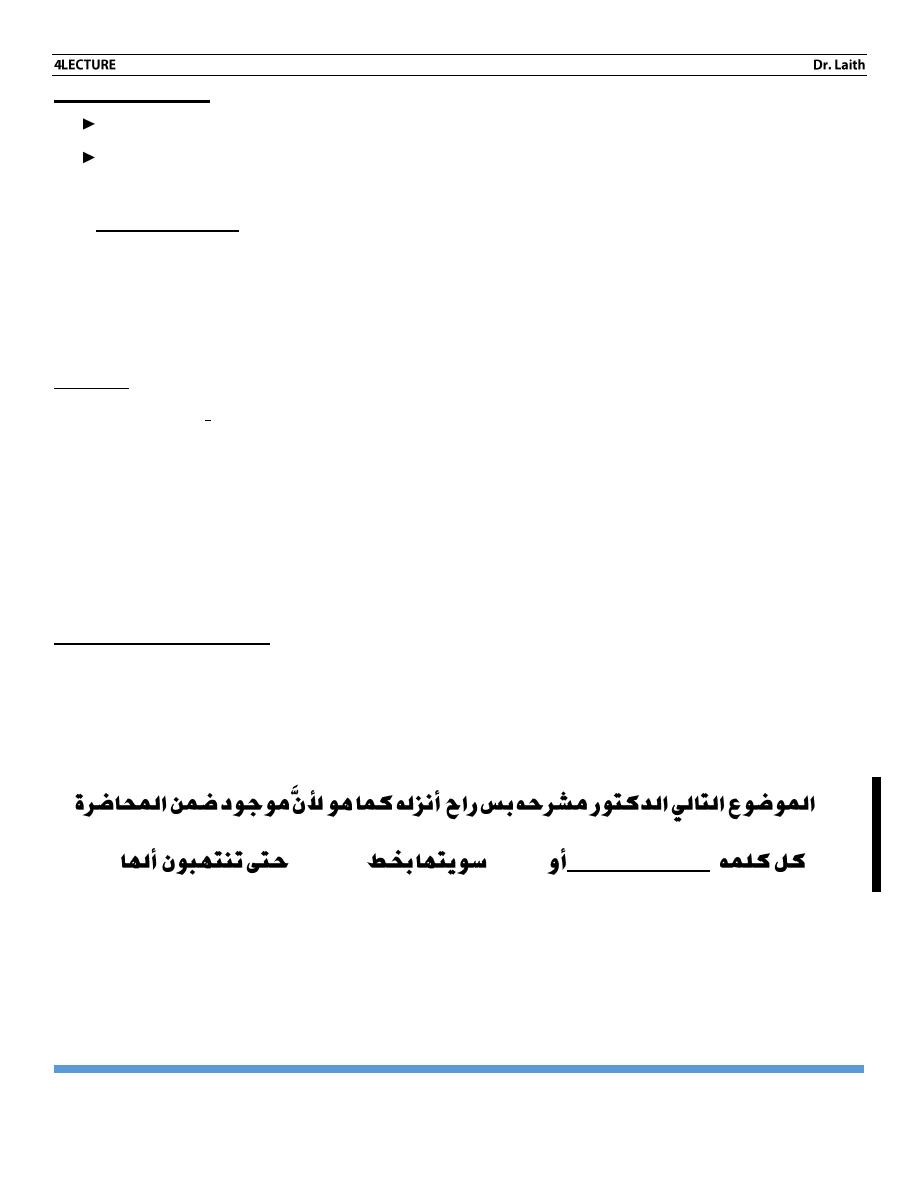
CXR
RadioLoGY
lecture
4
جامعة بغداد
–
كلية الطب
Chest X-Ray
ؤيد
م بتكم
MUSTAFA JASIM
Dr Laith

RADIOLOGY
CHEST RADIOLOGY
1
PAGE
Chest Radiology
Airway diseases
Bronchial asthma:
In children, the lungs may be over expanded between attacks & show bronchial
wall thickening with prominent hilar vasculature.
In adults, CXR is usually normal & its purpose is to diagnose the complications
or to demonstrate pneumonia that may have precipitated the attack.
During the attack, the lungs are recognizably over-expanded. Atelectasis of a
lobe or part of a lobe & may be persistent or recurrent problem.
Atelectasis in asthma is common & is caused by retained secretions. Atelectasis
present with greater degree of volume loss than the degree of volume loss in
pneumonia.
In older children & adults, they may be part of allergic bronchpulmonary
aspergillosis.
Pneumothorax is very rare complication.
Pneumomediastinum is more common.
Extrinsic compression of the trachea:
It can occur in cases of masses & congenital vascular anomalies.
In case of a mass, the mass will appear as a focal mediastinal widening with
displacement or compression of the trachea.
Remember that tracheal narrowing may be visible only in lateral view.
In case of a congenital vascular anomalies (e.g. double aortic arch), CXR may
not be able to diagnose congenital vascular anomalies, due to the presence of
thymus in that age group.
On barium swallow, there may be indentation of barium-filled esophagus.
CT & MRI are needed for detailed diagnosis.

RADIOLOGY
CHEST RADIOLOGY
2
PAGE
Chronic obstructive airway disease:
Involve chronic bronchitis, emphysema, bronchiectasis & cystic fibrosis. These
diseases may coexist.
Chronic bronchitis:
CXR is usually normal.
Any detectable abnormality noted on CXR is usually due to complications or
coexistent anomaly e.g. emphysema, pneumonia or cor pulmonale.
Centrilobar emphysema:
Not recognizable unless cor pulmonale is present.
Panacinar emphysema:
Over expanded lungs pushing the diaphragm down & become flattened with
narrowing of the heart shadow with widening of the ribs & attenuation of the
blood vessels (that can be generalized or localized [bulla]). The margins of
the bullous areas is bounded by a sharp line or imperceptible.
CT is more informative & show reduction in size & number of blood vessels
with a lower attenuation of the pulmonary parenchyma.
Bronchiectasis:
Defined as irreversible dilatation of the bronchi.
Can be caused by:
1. Pulmonary infection in childhood.
2. Cystic fibrosis.
3. Longstanding bronchial obstruction.
CXR may show tubular or ring shadows & may appear opaque or with air-fluid
level (if filled with mucus). There may be persistent consolidation with dilated
bronchi; loss of volume of affected lobe (is almost invariable). CXR may
appear normal.

RADIOLOGY
CHEST RADIOLOGY
3
PAGE
CT confirm the diagnosis; show the extent of the disease. It shows dilated &
thick walled bronchi with reduction of volume of the affected lobe. Normally,
the diameter of bronchus is equal to that of adjacent artery.
Cystic fibrosis:
CXR & CT may show:
Small ill-defined consolidation (noted in the upper zones) +- cavitation.
Bronchial wall thickening & signs of bronchiectasis (involving upper zones).
Airway obstruction with low, flat, diaphragm with narrow heart (unless there
is cor pulmonale that increase the size of the heart).
Allergic bronchopulmonary aspergillosis:
In asthma, the fungus in mucus plugs damage the wall of the proximal bronchi
with resultant obstruction & localized dilatation of the affected bronchi.
CXR may show:
Large volume lungs.
Transient collapse/consolidation.
Visualization of bronchi from mucus plugging.
Bronchiectasis of proximal bronchi.
Respiratory distress in newborn:
Hyaline membrane disease:
It is a disease of preterm infant (due to deficiency of surfactant, which will lead to
collapse of alveoli & prevent gas exchange).
CXR may show widespread very small pulmonary opacities with visible air
bronchograms. The changes are uniform in distribution.
In mild form, air bronchograms may be the most obvious & easily recognized
sign.
In severe forms, the pulmonary opacities become more confluent (opaque lungs).

RADIOLOGY
CHEST RADIOLOGY
4
PAGE
Pulmonary hemorrhage:
This is Radiologically similar to hyaline membrane disease.
Meconium aspiration:
CXR may show patchy & streaky pulmonary shadowing with no air
bronchograms & low-lying diaphragm.
Transient tachypnoea of newborn:
Clinically similar to RDS but CXR may show: over inflation of the lungs with
widespread, streaky pulmonary opacities (similar to pulmonary oedema) with pleural
effusion.
Complications of therapy include lobar collapse, Pneumothorax &
pneumomediastinum.
Radiation pneumonitis & fibrosis:
CXR will initially appear normal. Within few weeks, ill-defined small shadows in
radiation fields. Then fibrosis will ensue resulting in dense, coarse shadowing that is
sharply demarcated from normal lung with loss of volume &n pleural thickening.
Inhaled foreign body:
Metallic foreign bodies are usually visible on CXR. Most FB are not radio opaque,
so this is not seen. Signs of airway obstruction in children (air trapping, atelactasis,
post obstructive pneumonia & may appear normal).
Air trapping will appear on expiratory film with increased lucency of the lungs
with reduction of the size of vessels with increased volume of the lung (flat
diaphragm & mediastinal shift). The most sensitive test is chest fluoroscopy.

RADIOLOGY
CHEST RADIOLOGY
5
PAGE
Hydrocarbon pneumonia:
Ingestion of petroleum frequently develop patchy consolidation at the bases of the
lungs (this will appear within one hour & slowly resolving about 2 weeks).
Pneumatoceles & pleural effusion may develop.
Bronchial carcinoma:
Diagnosis of bronchial carcinoma need bronchoscopic biopsy especially for
central tumors.
Radiologically, bronchial carcinoma is divided in central & peripheral
tumors.
Central tumors will appear as a hilar mass +/- collapse/consolidation.
Peripheral tumors will appear as round shadow with irregular edge
(lobulated, notched or infiltrating margin). Cavitation (especially in
squamous cell carcinoma) may appear as a thick & irregular cavity or thin &
smooth cavity. Rarely, bronchial carcinoma may show calcification on CT.
Signs of spread
(on CXR, CT, PET):
1. Hilar & mediastinal LAP (> 1 cm), but remember that not all enlarged nodes
mean metastases to LAP, enlargement can be reactive.
2. Pleural effusion (can be due to metastases, associated infection or coincidental
as in heart failure).
3. Invasion of mediastinum (on CXR, this can be suggested by the presence of wide
mediastinum & elevation of hemidiaphragm) but CT is better for assessing
mediastinal invasion by tumor.
4. Chest wall e.g. rib destruction.
5. Lymphangitis carcinomatosa means lymphatic vessels grossly distended & the
lungs become oedematous & appear similar to interstitial pulmonary oedema with
a normal heart size, hilar LAP +- lobar consolidation. The changes may appear
unilateral. 6. Hematogeneous Secondaries (may involve the lungs, bones, liver
or adrenal glands).

RADIOLOGY
CHEST RADIOLOGY
6
PAGE
Chest trauma:
52 شيست أكس راي وجاي قبل سؤال عليهـلا تافص عيمج هيف ًادج مهم عوضوم
A rib fracture can be diagnosed by noted a break or step in the cortex of a rib.
Special views may be necessary. Extrapleural swelling may be visible. Rib fractures
are frequently multiple & may result in a flail segment.
Pleural effusion often accompanies rib fractures. Pneumothorax may occur, air-
fluid level in pleural cavity due to associated hemorrhage.
Surgical emphysema of the chest wall & mediastinal emphysema may be noted.
Pulmonary contusion: localized traumatic alveolar hemorrhage & oedema may be
seen whether yes or no rib fracture can be identified. The resulting shadow is similar
to consolidation.
ARDS may follow severe trauma to any part of body.
Rupture of diaphragm may permit herniation of stomach or intestines into the
chest (more common on the left). Gas shadows of stomach or intestines are seen
above the presumed position of the diaphragm. Ba meal & follow-through may be
indicated to establish the diagnosis. US may demonstrate the tear.
Rupture of aorta is surgical emergency & is best diagnosed by arteriography or
CT angiography. Mediastinal widening +/- pleural fluid is the plain film sign of
ruptured aorta. CT may be used to confirm or exclude blood in the mediastinum.
Catheter aortography or CT angiography is usually indicated in patients with
mediastinal widening due to hemorrhage following trauma to establish the diagnosis
of aortic rupture.
After months or years, there may be development of aortic aneurysm.
Rupture of tracheobronchial tree occur in major chest trauma & result in
pneumomediastinum or Pneumothorax. The main complication is subsequent
bronchostenosis.
Pulmonary metastases:
The hallmark is the presence of one or more pulmonary nodules maximal peripherally, usually with well-
defined (sometimes irregular) border. Cavitation may occur in Secondaries from squamous cell carcinoma.
Calcification is unusual in metastases (occur in sarcomas like osteosarcoma)
The initial radiological investigation is CXR & CT is the most sensitive but cannot differentiate Secondaries
from benign processes.

RADIOLOGY
CHEST RADIOLOGY
7
PAGE
Pleural diseases
Pleural fluid:
Has the same appearance on CXR, CT & MRI regardless its cause.
Large effusion may hide abnormality in the underlying lung.
U/S is a simple method of determining whether fluid is present.
Causes:
1. Pneumonia: may be visible on CXR.
2. Malignancy: frequently causes large effusion, in addition to the presence
of signs of bronchial carcinoma.
3. Heart failure: frequently cause bilateral in acute heart failure (more
prominent on the right).
4. Pulmonary infarction: cause small pleural effusion, in addition to the
presence of a pulmonary shadow.
5. Collagen vascular disease, nephrotic syndrome, renal failure, ascites
(these conditions are associated with bilateral effusion).
6. Pleural hemorrhage (in trauma, aortic dissection, ruptured bullae, pleural
metastasis).
Imaging findings:
CXR:
Blunting of costophrenic angles & the fluid surrounds the lung & lie higher
laterally than medially & run into the fissure especially the lower end of the
oblique fissure.
Subpulmonary effusion may appear similar to the shape of a normal diaphragm.
Compression collapse of the underlying lung is inevitable.
Sometimes, pleural effusion & collapse are due to the same condition.
Up to 300 ml may be impossible to detect in CXR PA & lat.

RADIOLOGY
CHEST RADIOLOGY
8
PAGE
CT:
Fluid density lie between the lung & chest wall & it cannot differentiate
between transudate & exudate, but can distinguish pleural effusion from
consolidation.
U/S:
Transonic region between the lung & diaphragm & in addition to diagnosis, US
can aid in guiding of aspiration.
Loculated effusion: may simulate tumor on CXR. US is used to confirm the presence
of effusion & assess the size & shape of pleural collection against the chest wall or
diaphragm & guide aspiration.
Pleural thickening:
It may follow pleural effusion especially following infection & pleural
hemorrhage.
In CXR, it appears similar to pleural effusion, so need US or CT to resolve the
problem
Localized plaques of thickening occur in asbestose exposure.
Pleural tumors:
Can be either primary (mesothelioma) or secondary. Mesothelioma occur in
asbestose exposure, so there may features of asbestose exposure.
Pleural calcification:
Can be:
Unilateral as in pleural hemorrhage, TB & empyema.
Bilateral as in asbestos exposure.
No obvious cause.

RADIOLOGY
CHEST RADIOLOGY
9
PAGE
Pneumothorax:
Pleural line forming the lung edge.
Absence of vessels shadow outside the lung.
Radiologically, after confirming the presence of Pneumothorax, we have to see
if there is a tension Pneumothorax or not?
Tension Pneumothorax will cause mediastinal shift & flattening of the ipsilateral
diaphragm.
Causes:
1. Idiopathic.
2. Emphysema.
3. Trauma.
4. pulmonary fibrosis
5. Pneumocystis carinii.
6. Secondaries.
Hydropneumothorax:
Will cause air fluid level.
Radiologically
CXR
BOLD

RADIOLOGY
CHEST RADIOLOGY
11
PAGE
Mediastinum
The mediastinum is divided into anterior, middle & posterior compartments, but
mediastinal masses can cross from one compartment to the other.
Masses are classified according to their position in the mediastinum. So if a mass
is identified on frontal CXR, take a lateral CXR to localize the mass.
CT & MRI of normal mediastinum:
These cross sectional studies can display normal anatomy & distinguish fat,
various soft tissue & blood vessels.
1. the bulk of the mediastinum is due to blood vessels,
2. The thymus, oesophagus, trachea & bronchi can be seen.
3. Lymph nodes are not visible if normal in size.
4. the size listed below normally contain nothing but fat or small LN:
Between the right tracheal wall & adjacent lung.
Between the right oesophageal wall & adjacent lung.
Anterior & to the left of the aorta & main pulmonary arteries.
Causes of anterior mediastinal mass:
1. Thyroid tumor.
2. Thymic tumor or cyst.
3. Teratoma/Dermoid cyst.
4. LAP.
5. Aortic aneurysm.
6. Pericardial cyst.
7. Fat pad.
8. Morgagni hernia.

RADIOLOGY
CHEST RADIOLOGY
11
PAGE
Causes of middle mediastinal mass:
1. Thyroid tumor.
2. LAP.
3. Bronchogenic cyst.
4. Aortic aneurysm.
Causes of posterior mediastinal mass:
1. Neurogenic tumor.
2. Soft tissue mass of vertebral infection or neoplasm.
3. LAP
4. Aortic aneurysm.
Mediastinal masses:
CXR:
Intrathoracic goiter will form superior mediastinal mass extends from the neck
& compress or displace the trachea.
LAP may occur in any of the three compartments & produce lobulated
mediastinal outline& may be present in multiple locations.
Neurogenic tumors are the commonest posterior mediastinal mass. There may
be pressure deformity of the adjacent ribs or spine.
Tumors confined to the anterior mediastinum: e.g. dermoid cysts & thymomas.
Calcification occurs in many conditions except malignant LAP.
Hiatal hernia may cause air-fluid level that is best seen on lateral view.
Masses in the right cardiophrenic angle are never of clinical importance (e.g.
fat pad, pericardial cyst, Morgagni hernia).
CT:
Provides information about the site, shape, size of the mass & so narrows the
list of differential diagnosis.
Contiguity with the thyroid suggest goiter as the cause of mediastinal mass.

RADIOLOGY
CHEST RADIOLOGY
12
PAGE
Multiple oval masses suggest LAP as the cause of the mass.
Fat density in a mediastinal mass suggests fat pad, mediastinal lipomatosis or
dermoid cyst.
Attenuation higher than that of a muscle suggest goiter.
Enhancement of mass suggests vascular origin or aneurysm.
Clear fluid in a mediastinal mass suggests pericardial cyst or bronchogenic
cyst.
MRI:
Rarely indicated to assess mediastinal masses. There is no need for contrast to
diagnose aneurysms & vascular anomalies & show the relation of posterior
mediastinal mass to the spinal canal.
Pneumomediastinum:
Means air in the mediastinum & this may track from:
The neck.
Adjacent chest wall.
Retroperitoneum.
Air leak from the oesophagus , trachea , bronchi or pulmonary tear (that can be
due to trauma [e.g. endoscopy or FB] or spontaneous [e.g. asthma])
Hilar enlargement:
Normal hilar shadows composed from pulmonary arteries & veins. The main lower
lobe artery normally measures 9-16 mm in diameter.
Hilar enlargement can be caused by enlarged blood vessels or mass (that can be
caused by LAP or bronchial carcinoma)
CXR in enlargement of pulmonary arteries:

RADIOLOGY
CHEST RADIOLOGY
13
PAGE
There may be a branching pattern. The shadowing is usually bilateral. There is
usually cardiomegaly. In spite of these radiographic features, sometimes CT is
needed to confirm the diagnosis.
CXR in LAP:
Produce lobulated hilar enlargement.
Causes of unilateral LAP:
1. Metastasis from Ca bronchus.
2. Lymphoma.
3. Infection e.g. TB.
Causes of bilateral LAP:
1. Sarcoidosis: symmetrical +/- right paratracheal LAP +/- parenchymal changes.
2. Lymphoma.
3. TB or fungal diseases.
CXR in neoplastic hilar enlargement:
Ca bronchus +/- lobar collapse/consolidation & narrowing of adjacent bronchus.
Diaphragm:
May be pushed by abdominal distension or pulled as a result of pulmonary disease.
Unilateral elevation of hemidiaphragm:
1. Pulmonary collapse.
2. Abdominal pathology e.g. mass or subdiaphragmatic abscess.
3. Incidental findings if minor elevation is noted.
4. Paralysis (as a result of disease of phrenic n. e.g. invasion by Ca bronchus) so
the diaphragm moves up with inspiration.
5. Eventration; in that case the diaphragm lacks muscle fibers; the majority
involves the left hemidiaphragm & is markedly elevated.

RADIOLOGY
CHEST RADIOLOGY
14
PAGE
Chest wall:
Must be examined for soft tissue swelling or rib abnormality.
Soft tissue swelling may occur from rib lesions e.g. fracture, infection & tumors.
Rib abnormality occurs in cases of Paget's disease, myeloma, Secondaries,
invasion from underlying carcinoma, rib notching.
Congenital rib anomalies are common e.g. bifid ribs, fused rib.
Mammography
Mammographic appearances vary from women to women. Mammography is used to
screen women for breast cancer & to investigate breast masses.
Mammographic appearances of carcinoma:
Mass with ill-defined or speculated borders.
Microcalcifications.
Distortion of adjacent stroma.
Skin thickening.
Mammographic appearances of benign masses:
Well defined mass.
Large coarse ring like calcifications.
Breast US can differentiate a mass as cystic (mostly benign) or solid (possibly
malignant).
The end of the lecture 4
